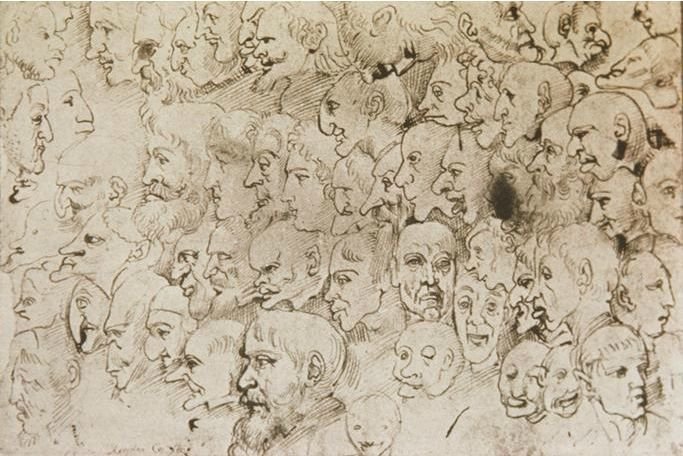Caricature has long been a unique form of expression that combines humor with observation, capturing the essence of a person through exaggerated features. Its history reveals a dynamic evolution that mirrors changes in society, art, and technology. This article traces caricature’s journey from ancient times to the modern era, showcasing its role as both an art form and a tool for social commentary.
1. Caricature Origins: The Ancient World
Caricature’s roots can be found in the ancient civilizations of Egypt, Greece, and Rome. In these societies, artists would exaggerate human features in sculptures, wall paintings, and pottery to portray powerful figures with distinct characteristics.
Examples from History:
- Ancient Egyptian Art: Hieroglyphics and wall paintings sometimes depicted pharaohs and deities with emphasized features, signaling their divine or royal status.
- Greek and Roman Satire: Early Roman mosaics and Greek pottery displayed exaggerated human forms, often for humorous effect.
2. Renaissance Europe: The Birth of Modern Caricature
Caricature as we recognize it today began to take shape during the Renaissance. Artists like Leonardo da Vinci and Annibale Carracci explored exaggerated depictions as part of their study of human anatomy and personality.
| Artist | Notable Work | Contribution |
|---|---|---|
| Leonardo da Vinci | Series of grotesque heads (1490s) | Experimented with exaggerated facial expressions |
| Annibale Carracci | Satirical sketches in the late 16th century | Known for lively, exaggerated sketches of people |
Interesting Fact: Da Vinci’s grotesque sketches, also known as “grotesques,” served as studies of facial expressions and proportions, pushing the boundaries of naturalism.
3. The Golden Age of Caricature: 18th and 19th Century Europe
By the 18th century, caricature had become a popular medium for satire, especially in England and France. Caricaturists used humor and exaggeration to critique politics, fashion, and societal norms. During this period, figures like James Gillray and Honoré Daumier emerged, bringing caricature to new levels of public influence.
- James Gillray (England): Known as the “father of political cartooning,” Gillray used caricature to criticize the British monarchy and government.
- Honoré Daumier (France): A master of social satire, Daumier’s works highlighted class struggles and were instrumental in the development of modern political cartoons.
| Period | Notable Caricaturists | Subjects of Caricature |
|---|---|---|
| 18th Century | James Gillray, George Cruikshank | Monarchy, government, societal trends |
| 19th Century | Honoré Daumier | Social class, politics, legal system |
4. Early 20th Century: The Rise of Caricature in Media
In the 20th century, caricature adapted to new forms of media like newspapers and magazines. Political cartoons became a staple of journalism, often serving as critical commentary on current events. Famous artists of this time include David Low and Herblock (Herbert Block), who used caricature to highlight major issues of the era, from war to civil rights.
- David Low (New Zealand/UK): Known for his powerful anti-fascist cartoons during WWII.
- Herblock (USA): A Pulitzer Prize-winning cartoonist, Herblock was known for his criticism of McCarthyism and the Vietnam War.
5. Caricature in the Digital Age: A New Frontier
With the advent of digital tools, caricature has transformed once again. Digital caricature apps and software like Adobe Photoshop allow artists to create highly detailed, shareable works. Social media platforms have made it easy for artists to reach global audiences, and caricature has become a key part of pop culture.
- Digital Tools: Adobe Photoshop, Procreate, and digital sketching tools allow for highly customized caricature styles.
- Social Media Influence: Artists share their work on Instagram, Twitter, and TikTok, helping caricature reach a broader, more diverse audience.
6. Caricature as Social Commentary
Throughout its history, caricature has been more than entertainment. It’s a form of expression that holds up a mirror to society. From criticizing monarchies to commenting on social media influencers, caricature continues to reflect the pulse of society in humorous but insightful ways.
Suggested Further Reading & Sources
- Books:
- The History of Cartoons and Caricature by Mark Bryant
- The Art of Caricature by Thomas Nast
- Online Archives:
- British Museum Online Collection – View James Gillray’s caricatures.
- Library of Congress Digital Archives – Collections of early American caricature work.
Author’s Comment:
Caricature is one of the most enduring and adaptable art forms. It fascinates me how artists can capture the essence of a person or situation with just a few strokes. While researching this article, I was struck by how much caricature has been shaped by the times and, in turn, has influenced public opinion. Whether digital or drawn by hand, caricature remains a vibrant way to explore the human experience.
This article provides readers with an engaging look at the development of caricature, showcasing its artistic and cultural impact over centuries. Let me know if you’d like more details or adjustments!

